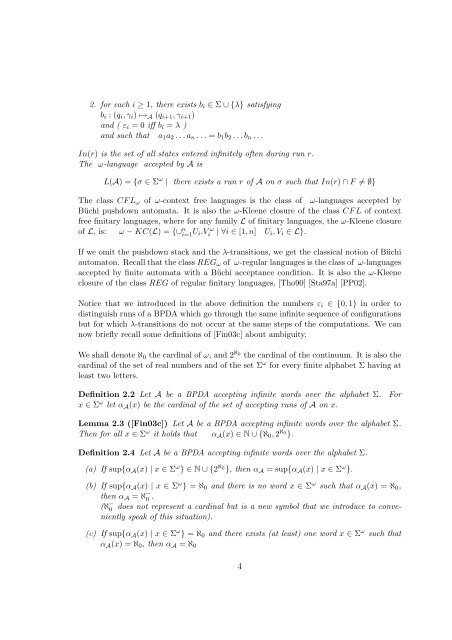Topology and ambiguity in ω-context free languages - HAL
Topology and ambiguity in ω-context free languages - HAL
Topology and ambiguity in ω-context free languages - HAL
Create successful ePaper yourself
Turn your PDF publications into a flip-book with our unique Google optimized e-Paper software.
2. for each i ≥ 1, there exists b i ∈ Σ ∪ {λ} satisfy<strong>in</strong>g<br />
b i : (q i ,γ i ) ↦→ A (q i+1 ,γ i+1 )<br />
<strong>and</strong> ( ε i = 0 iff b i = λ )<br />
<strong>and</strong> such that a 1 a 2 ...a n ... = b 1 b 2 ...b n ...<br />
In(r) is the set of all states entered <strong>in</strong>f<strong>in</strong>itely often dur<strong>in</strong>g run r.<br />
The <strong>ω</strong>-language accepted by A is<br />
L(A) = {σ ∈ Σ <strong>ω</strong> | there exists a run r of A on σ such that In(r) ∩ F ≠ ∅}<br />
The class CFL <strong>ω</strong> of <strong>ω</strong>-<strong>context</strong> <strong>free</strong> <strong>languages</strong> is the class of <strong>ω</strong>-<strong>languages</strong> accepted by<br />
Büchi pushdown automata. It is also the <strong>ω</strong>-Kleene closure of the class CFL of <strong>context</strong><br />
<strong>free</strong> f<strong>in</strong>itary <strong>languages</strong>, where for any family L of f<strong>in</strong>itary <strong>languages</strong>, the <strong>ω</strong>-Kleene closure<br />
of L, is: <strong>ω</strong> − KC(L) = {∪ n i=1 U i.Vi <strong>ω</strong> | ∀i ∈ [1,n] U i ,V i ∈ L}.<br />
If we omit the pushdown stack <strong>and</strong> the λ-transitions, we get the classical notion of Büchi<br />
automaton. Recall that the class REG <strong>ω</strong> of <strong>ω</strong>-regular <strong>languages</strong> is the class of <strong>ω</strong>-<strong>languages</strong><br />
accepted by f<strong>in</strong>ite automata with a Büchi acceptance condition. It is also the <strong>ω</strong>-Kleene<br />
closure of the class REG of regular f<strong>in</strong>itary <strong>languages</strong>, [Tho90] [Sta97a] [PP02].<br />
Notice that we <strong>in</strong>troduced <strong>in</strong> the above def<strong>in</strong>ition the numbers ε i ∈ {0, 1} <strong>in</strong> order to<br />
dist<strong>in</strong>guish runs of a BPDA which go through the same <strong>in</strong>f<strong>in</strong>ite sequence of configurations<br />
but for which λ-transitions do not occur at the same steps of the computations. We can<br />
now briefly recall some def<strong>in</strong>itions of [F<strong>in</strong>03c] about <strong>ambiguity</strong>.<br />
We shall denote ℵ 0 the card<strong>in</strong>al of <strong>ω</strong>, <strong>and</strong> 2 ℵ 0<br />
the card<strong>in</strong>al of the cont<strong>in</strong>uum. It is also the<br />
card<strong>in</strong>al of the set of real numbers <strong>and</strong> of the set Σ <strong>ω</strong> for every f<strong>in</strong>ite alphabet Σ hav<strong>in</strong>g at<br />
least two letters.<br />
Def<strong>in</strong>ition 2.2 Let A be a BPDA accept<strong>in</strong>g <strong>in</strong>f<strong>in</strong>ite words over the alphabet Σ. For<br />
x ∈ Σ <strong>ω</strong> let α A (x) be the card<strong>in</strong>al of the set of accept<strong>in</strong>g runs of A on x.<br />
Lemma 2.3 ([F<strong>in</strong>03c]) Let A be a BPDA accept<strong>in</strong>g <strong>in</strong>f<strong>in</strong>ite words over the alphabet Σ.<br />
Then for all x ∈ Σ <strong>ω</strong> it holds that α A (x) ∈ N ∪ {ℵ 0 ,2 ℵ 0<br />
}.<br />
Def<strong>in</strong>ition 2.4 Let A be a BPDA accept<strong>in</strong>g <strong>in</strong>f<strong>in</strong>ite words over the alphabet Σ.<br />
(a) If sup{α A (x) | x ∈ Σ <strong>ω</strong> } ∈ N ∪ {2 ℵ 0<br />
}, then α A = sup{α A (x) | x ∈ Σ <strong>ω</strong> }.<br />
(b) If sup{α A (x) | x ∈ Σ <strong>ω</strong> } = ℵ 0 <strong>and</strong> there is no word x ∈ Σ <strong>ω</strong> such that α A (x) = ℵ 0 ,<br />
then α A = ℵ − 0 .<br />
(ℵ − 0 does not represent a card<strong>in</strong>al but is a new symbol that we <strong>in</strong>troduce to conveniently<br />
speak of this situation).<br />
(c) If sup{α A (x) | x ∈ Σ <strong>ω</strong> } = ℵ 0 <strong>and</strong> there exists (at least) one word x ∈ Σ <strong>ω</strong> such that<br />
α A (x) = ℵ 0 , then α A = ℵ 0<br />
4
















